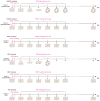Isolation of a T7-Like Lytic Pasteurella Bacteriophage vB_PmuP_PHB01 and Its Potential Use in Therapy against Pasteurella multocida Infections
- PMID: 30669600
- PMCID: PMC6356340
- DOI: 10.3390/v11010086
Isolation of a T7-Like Lytic Pasteurella Bacteriophage vB_PmuP_PHB01 and Its Potential Use in Therapy against Pasteurella multocida Infections
Abstract
A lytic bacteriophage PHB01 specific for Pasteurella multocida type D was isolated from the sewage water collected from a pig farm. This phage had the typical morphology of the family Podoviridae, order Caudovirales, presenting an isometric polyhedral head and a short noncontractile tail. PHB01 was able to infect most of the non-toxigenic P. multocida type D strains tested, but not toxigenic type D strains and those belonging to other capsular types. Phage PHB01, the first lytic phage specific for P. multocida type D sequenced thus far, presents a 37,287-bp double-stranded DNA genome with a 223-bp terminal redundancy. The PHB01 genome showed the highest homology with that of PHB02, a lytic phage specific for P. multocida type A. Phylogenetic analysis showed that PHB01 and PHB02 were composed of a genus that was close to the T7-virus genus. In vivo tests using mouse models showed that the administration of PHB01 was safe to the mice and had a good effect on treating the mice infected with different P. multocida type D strains including virulent strain HN05. These findings suggest that PHB01 has a potential use in therapy against infections caused by P. multocida type D.
Keywords: P. multocida type D; bacteriophage; isolation; lytic; therapeutic application.
Conflict of interest statement
The authors declare no conflict of interest.
Figures








Similar articles
-
Complete Genome Sequence of a Novel T7-Like Bacteriophage from a Pasteurella multocida Capsular Type A Isolate.Curr Microbiol. 2018 May;75(5):574-579. doi: 10.1007/s00284-017-1419-3. Epub 2018 Jan 6. Curr Microbiol. 2018. PMID: 29307051
-
Isolation and genome analysis of a lytic Pasteurella multocida Bacteriophage PMP-GAD-IND.Lett Appl Microbiol. 2018 Sep;67(3):244-253. doi: 10.1111/lam.13010. Epub 2018 Jul 17. Lett Appl Microbiol. 2018. PMID: 29808940
-
Isolation and sequencing of a temperate transducing phage for Pasteurella multocida.Appl Environ Microbiol. 2006 May;72(5):3154-60. doi: 10.1128/AEM.72.5.3154-3160.2006. Appl Environ Microbiol. 2006. PMID: 16672452 Free PMC article.
-
Immunogens of Pasteurella.Vet Microbiol. 1993 Nov;37(3-4):353-68. doi: 10.1016/0378-1135(93)90034-5. Vet Microbiol. 1993. PMID: 8116191 Review.
-
Pathogenomics of Pasteurella multocida.Curr Top Microbiol Immunol. 2012;361:23-38. doi: 10.1007/82_2012_203. Curr Top Microbiol Immunol. 2012. PMID: 22402726 Review.
Cited by
-
Therapeutic Efficacy of Phage PIZ SAE-01E2 against Abortion Caused by Salmonella enterica Serovar Abortusequi in Mice.Appl Environ Microbiol. 2020 Oct 28;86(22):e01366-20. doi: 10.1128/AEM.01366-20. Print 2020 Oct 28. Appl Environ Microbiol. 2020. PMID: 32887718 Free PMC article.
-
Phage-Derived Depolymerase: Its Possible Role for Secondary Bacterial Infections in COVID-19 Patients.Microorganisms. 2023 Feb 7;11(2):424. doi: 10.3390/microorganisms11020424. Microorganisms. 2023. PMID: 36838389 Free PMC article. Review.
-
Genome sequencing of Pasteurella multocida phage PMP1 elucidates a possible host resistance mechanism and suggests that it belongs to a new species.Arch Virol. 2025 Jul 10;170(8):176. doi: 10.1007/s00705-025-06357-8. Arch Virol. 2025. PMID: 40637897
-
Identification of a broad-spectrum lytic Myoviridae bacteriophage using multidrug resistant Salmonella isolates from pig slaughterhouses as the indicator and its application in combating Salmonella infections.BMC Vet Res. 2022 Jul 12;18(1):270. doi: 10.1186/s12917-022-03372-8. BMC Vet Res. 2022. PMID: 35821025 Free PMC article.
-
Characterization and therapeutic evaluation of the lytic bacteriophage ENP2309 against vancomycin-resistant Enterococcus faecalis infections in a mice model.Virol J. 2025 Aug 28;22(1):292. doi: 10.1186/s12985-025-02917-1. Virol J. 2025. PMID: 40877963 Free PMC article.
References
-
- Carter G.R. Studies on Pasteurella multocida. I. A hemagglutination test for the identification of serological types. Am. J. Vet. Res. 1955;16:481–484. - PubMed
-
- Abreu F., Rodriguez-Lucas C., Rodicio M.R., Vela A.I., Fernandez-Garayzabal J.F., Leiva P.S., Cuesta F., Cid D., Fernandez J. Human Pasteurella multocida Infection with Likely Zoonotic Transmission from a Pet Dog, Spain. Emerg. Infect. Dis. 2018;24:1145–1146. doi: 10.3201/eid2406.171998. - DOI - PMC - PubMed
Publication types
MeSH terms
Substances
Grants and funding
LinkOut - more resources
Full Text Sources
Other Literature Sources

